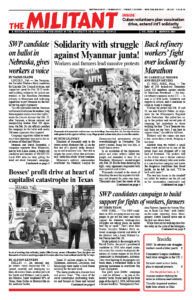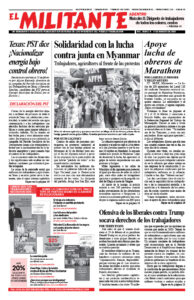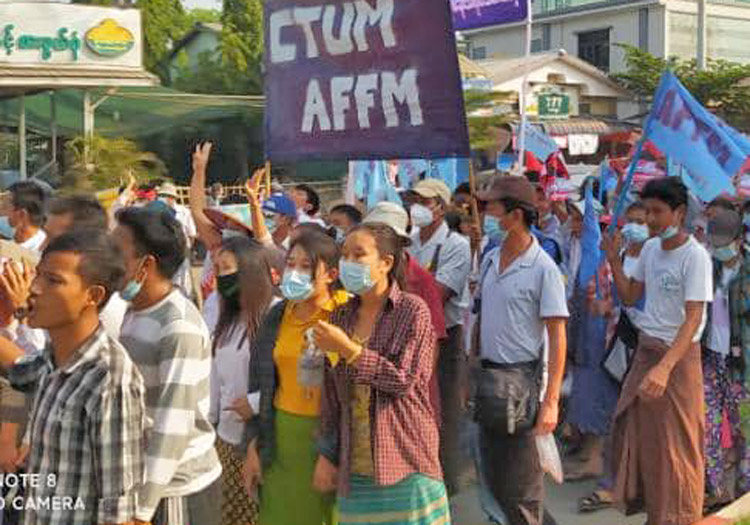Hundreds of thousands took to the streets across Myanmar Feb. 22 on the first day of a general strike demanding an end to military rule. They did so despite the junta’s threat that protesters will “suffer loss of life” if they continue.
Myanmar’s military commanders overthrew the National League for Democracy-led government elected overwhelmingly in November. The party’s leader, Aung San Suu Kyi, is under house arrest.
In an escalation of the repression, police and army soldiers killed two people and wounded at least 30 in Mandalay, Myanmar’s second-largest city, Feb. 20. But far from deterring the fight, coup opponents responded with more protests and strikes.
Thousands returned to the streets of Mandalay the next day to protest the killings and demand the junta step down. Thousands also lined the streets of the capital, Naypyitaw, chanting, “Our uprising must succeed!” for the funeral of 19-year-old student Mya Thewt Thewt Khine. She was shot in the head Feb. 9, the first protester killed since the coup.
Other protests across the country Feb. 21 included thousands of farmworkers and farmers, who marched in the small town of Hlegu north of Yangon.
As the general strike began, police arrested nearly 200 as thousands from the surrounding countryside attempted to enter Naypyitaw. The sparsely populated city was set up as the capital by the military in 2005 to insulate it from protests in Yangon, the country’s largest city and former capital.
Almost the entire population of Yangon, some 5 million in a country of 53 million, “was joining the moving rivers of people along major roads in the city,” reported Myanmar Now news service.
Suu Kyi was arrested for the first time in 1989, after the military massacred thousands to crush massive protests. She became head of the government after winning the election in 2015, just five years after being released from her most recent house arrest.
Since the 2015 election Suu Kyi has often collaborated with the generals, especially in defending the military’s brutal repression of the Rohingya people in Rakine state. But she is still viewed by many as a symbol of opposition to the military and its long history of bloody rule. Her father, Aung San, was a central leader of the independence struggle against British imperialism and was assassinated in 1947.
Under the 2008 constitution, drawn up by the military, the generals appoint 25% of the seats in parliament, granting them veto power over government decisions. But they still feared that the 2020 election results would lead to inroads on their grip on power, including their many lucrative corporate holdings in combination with foreign capital.
Security forces open fire
The deadly assault in Mandalay took place after working people rushed to the Yadanabon dockyard to support workers who had refused a police order to load a boat with oil.
Teenage market laborer Wai Yan Tun was shot in the head and killed. Carpenter Thet Naing Win, 36, was killed with a shot to the chest. The security forces threw spikes — designed to cut through sandals — as they charged into the crowd.
“They even fired on ambulances and medical personnel taking the wounded to the hospital,” Yon Yati Naing, told the Militant during a solidarity protest in New York Feb. 20.
Myanmar Now reported that soldiers involved in the assault are from the same notorious unit that carried out a massacre of Rohingya men and boys in Rakhine state in 2017.
Following the killings in Mandalay, 25 unions and other organizations formed the General Strike Committee, including the All Burma Federation of Trade Unions, the National League for Democracy, the Federation of Farmers’ Unions, the All Burma Federation of Student Unions, and the Saffron Monk Network, as well as women’s rights organizations, ethnic rights groups and other political parties.
The committee demands the release of all political prisoners, the repeal of the 2008 constitution, and the formation of a federal union that would guarantee the rights of ethnic minorities.
Legacy of British rule
Divisions between the ethnic minorities and the Burman majority are a legacy of British colonial rule. The Myanmar government officially recognizes 135 ethnic groups, but excludes the mostly Muslim Rohingya, who it falsely claims are “illegal” immigrants from Bangladesh, denying them citizenship.
Burma, renamed Myanmar in 1989, became independent in 1948. The British colonial regime had stoked ethnic divisions as part of its divide- and-rule strategy, largely excluding Burmans from the government. After independence the new government, now led predominantly by Burmans, enforced its own discrimination against other ethnic minorities.
The latest protests are notable for the participation of workers and farmers from all the ethnic groups. While many are skeptical of Suu Kyi, they are united in opposition to military rule.
Over the last decade Myanmar has become a major center for world garment production, with over 600,000 workers. Its main trading partner and supplier of its military is Beijing, but capitalist companies from Singapore, Japan and India have substantial investments, all attracted by wages that are roughly half those in Cambodia and Vietnam.
Workers and farmers in much of the country don’t have access even to basic services. As of 2014, two-thirds of households didn’t have electricity, 70% depended on firewood for cooking and barely 2% had flush toilets.
Workers and their unions have been at the forefront of the protests. Moe Sandar Myint, a leader of the Federation of General Workers, told garment workers at a Feb. 13 protest in Yangon that they had hoped that as the COVID-19 pandemic was ending and shutdowns lifted, there would be better opportunities to win higher wages and better conditions. But the military coup meant that “instead we face tears and sorrow,” she said.
“We are not fighting just for one political party,” Confederation of Trade Unions leader Phyo Sandar Soe told the crowd. “We are fighting for the whole nation and for the wishes of the Myanmar people.”


